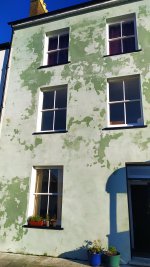Hi,
Last August I got the facade of my Georgian house lime rendered and lime washed. House is over 200 years old.
The guy who did the rendering used what he called a lime splatter coat using NHL 3.5 with 3 coats. Mix was 3/1 then scratch coast 3:1 - mix being 2 building sand, 1 sharp sand, 1 lime fibres. Top coat was 4 building sand, 1 lime roughly 10mm for scratch coat and same for finish.
Sorry this is his description and I have to say I am not sure what precisely this all means.
4 days after the lime render the house was lime washed over a series of consecutive days.
A couple of weeks later large splotches started to appear and have not gone away. There are also fine cracks appearing.
I would enormously appreciate any advice or suggestions on what has gone wrong here and how it can be fixed. Every time it rains the lme render gets damp but then dries out very quickly except these awful splotches never go away as seen in the attached photo. The guy who did the render says that he thinks it's the problem with the lime wash having been put on too soon and says we should wait for Summer. Even if it dries out over the Summer, which remains to be seen, won't these splotches reappear in the rainy Wintry months. Our painter who did the lime wash has disappeared We specifically wanted the house lime rendered/lime washed because of its age.
We specifically wanted the house lime rendered/lime washed because of its age.
Many thanks for any help and suggestions, Gwenn
Last August I got the facade of my Georgian house lime rendered and lime washed. House is over 200 years old.
The guy who did the rendering used what he called a lime splatter coat using NHL 3.5 with 3 coats. Mix was 3/1 then scratch coast 3:1 - mix being 2 building sand, 1 sharp sand, 1 lime fibres. Top coat was 4 building sand, 1 lime roughly 10mm for scratch coat and same for finish.
Sorry this is his description and I have to say I am not sure what precisely this all means.
4 days after the lime render the house was lime washed over a series of consecutive days.
A couple of weeks later large splotches started to appear and have not gone away. There are also fine cracks appearing.
I would enormously appreciate any advice or suggestions on what has gone wrong here and how it can be fixed. Every time it rains the lme render gets damp but then dries out very quickly except these awful splotches never go away as seen in the attached photo. The guy who did the render says that he thinks it's the problem with the lime wash having been put on too soon and says we should wait for Summer. Even if it dries out over the Summer, which remains to be seen, won't these splotches reappear in the rainy Wintry months. Our painter who did the lime wash has disappeared
Many thanks for any help and suggestions, Gwenn

